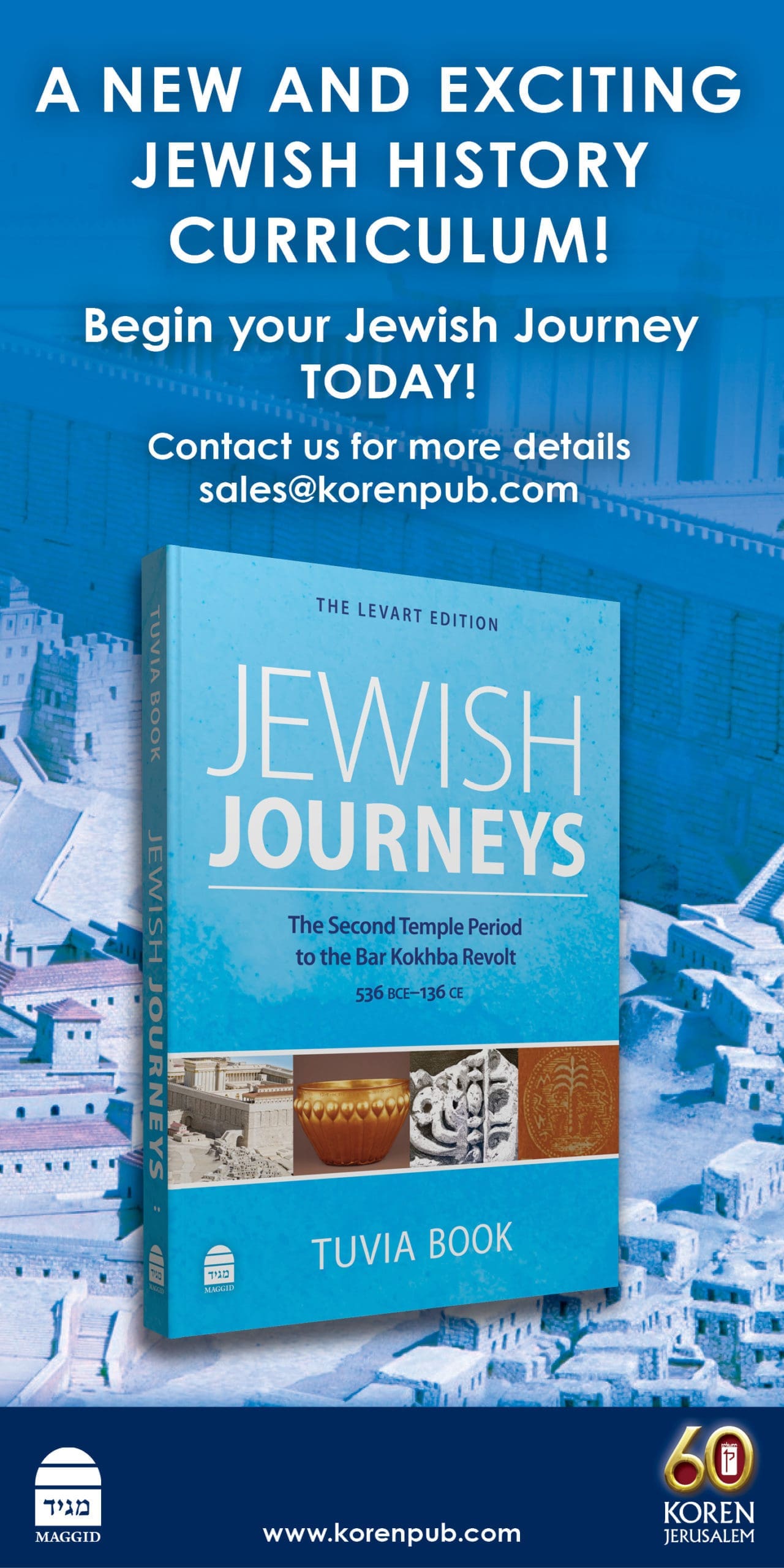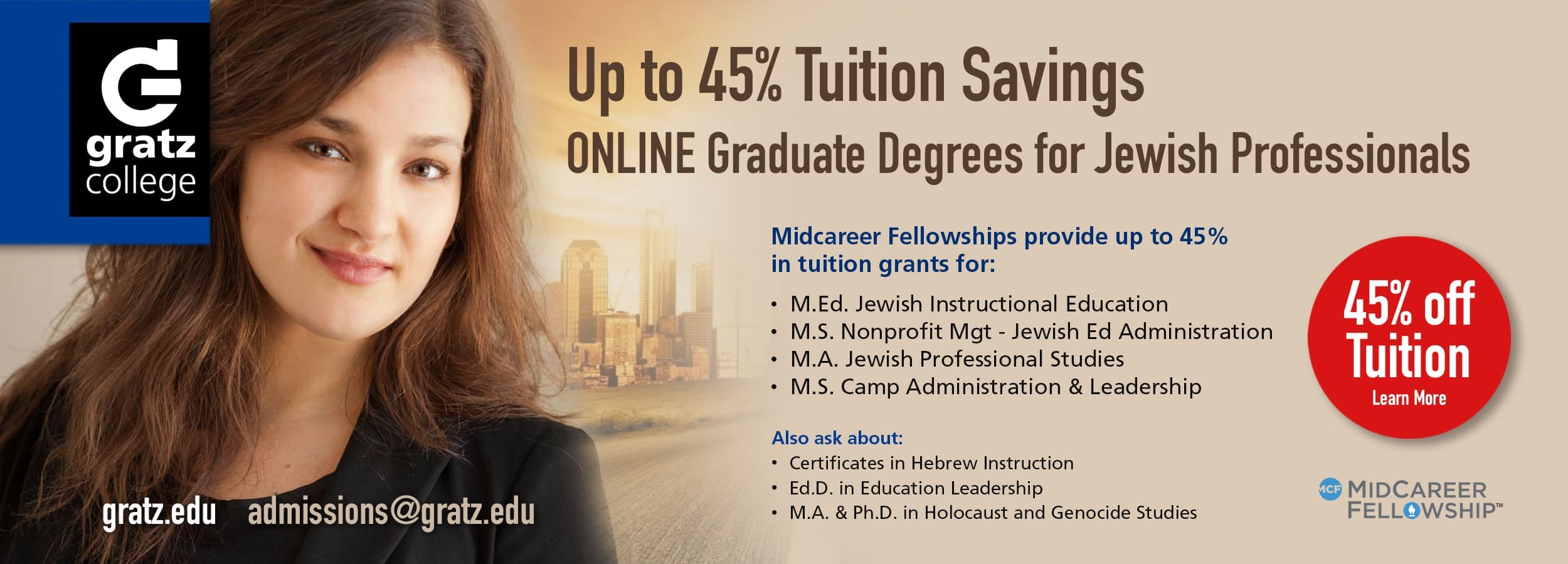Jewish Educational Leadership: Your office is like a mini-museum. How did you get started with artifacts?
Yoni Kadden: I had an aunt and uncle in Atlanta; their home was filled with antiques—even mundane things like a laundry detergent bucket from the 1940s. It was just something that I found deeply resonant. I’m deeply interested in material culture; it transports me to a different time. When my mother and I were cleaning out my grandmother’s house after she passed away, we came across this envelope that my mother, when she was a kid, received from cousins who lived in Alabama. Attached to the letter inside was a Confederate $5 bill, with a paperclip rusted on the bill itself. That was so exciting; I had a personal connection to the civil war. Shortly after that I learned that when Lincoln was assassinated, he had a Confederate $5 bill in his wallet. That cemented it for me. It made me feel connected to a particular moment in time, but also to a particular person—I shared something with President Lincoln.
Let me tell you how this affects my students. When we’re studying the antebellum period, we deep dive into abolitionist literature. One of the primary sources that we look at is The Liberator, which was a newspaper put out by William Lloyd Garrison here in the Boston area. We talk about it, we read a few articles, look at the masthead, and discuss why he took the particular approach to abolitionism that he did. And then I pull down off the wall an original copy of The Liberator which has been hanging there all along. It blows their mind. Even though they can’t actually touch it because it’s behind glass, they want to put their hands even on that frame. This emotional connection is palpably different than the intellectual discussion we’d just had about the newspaper and even the person behind it. To quote Ken Burns, “emotion is the glue of memory.”
One last quick story: Last summer, my family and I went to Philadelphia and visited the space where Thomas Jefferson wrote the Declaration of Independence, in an apartment building, not too far from Independence Hall. The ranger told us a couple of stories helping to bring Jefferson’s story to life. My daughter, who was about ten at the time, particularly loves this kind of stuff and started asking more questions. “Is that the desk where he wrote it at?” “Well, no, but it’s a pretty good replica of the desk.” “Is this his bed?” “Well, no, it’s a period bed, but there are a couple of artifacts we know belonged to Jefferson.” And then finally she asked, “Is this the actual house? Is this the actual apartment?” “No, they tore down the building and rebuilt it in the 1970s according to the blueprints and specifications described in letters that we have. We’re sure that this is what it would have looked like.” That was it; she was done. Reproductions and facsimiles don’t do it for her; she wanted the real thing. Her interest disappeared when she lost the possibility of that emotional bridge to a faraway time.
What do the students do with artifacts that you bring in?
There are two paths. One is the emotional one, which I just mentioned. But not everyone is going to have that nerdy historical connection like I had to a 1940s detergent bucket.
The other path is an intellectual one, where students begin to interrogate an artifact—usually a mundane one—which is really exciting. I have a 1920s washing machine, for example. It’s the size of a lobster pot with a little machine on top. I’ll put it on the table, have them all look around and then we start with the most important part, the questions, using what’s called the QFT, Question Formulation Technique. They ask questions, and every question gets recorded as asked. They’ll ask about the shape, the color, the knobs, the patent plaque, everything. They get curious. Then they categorize their questions, and afterwards they get to research their questions. They begin to discover all sorts of things—about the company that made it, when it was introduced, why it was invented, how it was advertised, how it changed people’s lives, and so much more. And here they have a tangible piece of that entire era—of historical change—in their hands; it becomes something sacred.
Just imagine that you had just studied a piece of text with commentary and then you broke it out in original parchment from, I don’t know, the 6th century. How do you think your students would react? It would probably change the emotional valence of that particular moment.
What role does imagination play in all of this?
That’s a great question.
Undoubtedly there’s something about imagination that is clicking in when you begin to appreciate an object and begin to feel connected to its time and space.
This is something I struggle with because it’s a little bit at odds with the historical thinking enterprise that I so deeply believe in and really want to emphasize with my students. Historical thinking is really all about grounding yourself in the texts and the evidence of what you know, contextualizing yourself in a moment in a factual way, and not taking liberties with it or going beyond what we know. By contrast, the act of imagination puts you in a space that may not have existed. Whenever I take my students to a place, I’m worried that they’re now imagining themselves historically inaccurately. But at some point, I got over that. I realized that, in the end, I have two goals. I want them to be intellectually solid in the way they approach history. In our world today there are way too many people rewriting history for their own purposes, without being grounded in anything historically accurate. That’s really problematic. I want my students to be historical thinkers, grounded in evidence. But I also want them to love history. I want them to fall in love with stories of the past, to feel connected to their past. I want them to feel part of the human community, both in terms of space and over time. I want them to feel part of this human experiment that we are living in on this planet and to feel connected to that larger chain of humanity over time. That’s an incredibly powerful thing. That leads to both a sense of humility and responsibility.
So yes, I also want my students to feel. It’s that emotional piece, including the imagination, that can really connect you to the past. I know that it’s fraught, but it’s really important.
You’re a teacher of American History. Would you imagine Jewish History as similar, or would there be differences?
It’s tricky, and it’s a question I debate all the time. This is a journey for me, and here’s where I stand now. On the one hand, if we treat Jewish History differently than any other subject of history we are belittling, infantilizing, and even dishonoring Jewish History. I dread the thought of treating Jewish History as something less than the great pursuit of using our historical thinking skills to try to make sense in a very complex, high-level way, of what happened in our past. So, for example, if I were teaching American Jewish History, I might take an advertisement from the OU in 1924 and interrogate it. How it was a unique product of the American Jewish scene. These are all historical thinking skills.
At the same time, I want students to feel a connectedness to the people that they are studying. I want them to feel like they are sitting there in 1924, on the Lower East Side of Manhattan, thinking about how Jews were strategizing how to maximize the Jewish community and also how to help Jews keep kosher and whether or not a rabbinic stamp of approval should be used for commercial purposes. I want my students to both understand and to feel that moment.
When I think of myself as Jew, I immediately go back to the 18th century; I think of myself as a Vilna Jew, even though most of the family Jewish story I grew up with is not from Vilna. It’s because of what I connected to in so much of my school learning and shul experiences. It wasn’t brought about by historical thinking, but by a sense of connectedness to the Jewish history probably learned in places like my eighth-grade rebbe-hagiography class. And that’s powerful. I don’t think that I would call it Jewish History, I would call it Jewish memory. Primary sources and artifacts ground you in the history, but the imagination moves us into memory.
It’s like holding that newspaper, The Liberator. We don’t really know what the Garrison’s office actually looked like in 1840, but I imagine myself standing there with this piece of paper which has just been printed. That’s incredibly powerful and moving to me. Is that history? Probably not. But is that important? I think it really is.
I resisted this for a long time. I was afraid that I was compromising my intellectual truth, or doing a disservice to my historical endeavor, or being disingenuous as a history teacher. I’m a history teacher, not a teacher of creative writing. But then I started thinking more about the larger endeavor about connecting us to the past. And that’s where artifacts come in. That’s where we really connect. Why are we connecting ourselves to the past in this way? We could just do it intellectually. So I think that it is important, and for sure in Jewish history as well. Balancing the historical thinking and skills with a sense of building memory. And that’s where imagination plays a great role.
Can you talk about the process a little. Kids ask questions to which you don’t necessarily have the answers. Is that scary?
I love that question. I’ll just speak to my own fundamental beliefs about what I’m doing in the classroom. I’m here as a fellow explorer, not to provide answers for them. I’m here to help them learn to ask questions, to become great questioners. When they’re writing a paper, the part I care most about is that initial phase, the iterative figuring out exactly what the right question is. Nothing excites me more than when I’ve come up with my own question for the day and then some student opens the class with a different question, something I hadn’t thought of—and it’s invariably so much better than mine. I’ll make the switch immediately; that new question will become the topic for the day, because the purpose of history is to notice things and ask questions about those things. I’m not a historian by training; I am a teacher of history. My job is to help students to learn to ask good questions and help them learn to explore and find good answers—and good answers aren’t immediate, they take time.
It’s not scary because I don’t believe my goal is to provide answers and things to memorize for them. My goal is for them to become historical thinkers and this is what accomplishes that. My goal is to help them feel a passion for their part, a bond with their history. Getting them there is exciting and invigorating.

Yoni Kadden joined the faculty of Gann Academy in 2000. His students have developed numerous artifact-centered public history projects including a nationally recognized museum of disability history, a published Yizkor Book of a community buried anonymously in a local cemetery, and the production of a play based on original letters from the Shoah. He has also designed and led place-based explorations for both students and educators including Civil Rights journeys to Alabama and a politics deep-dive in Washington, DC.
Reach 10,000 Jewish educational professionals. Advertise in the upcoming issue of Jewish Educational Leadership.







